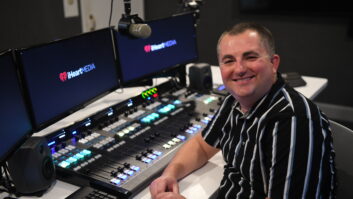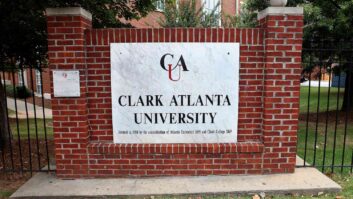
Roswell “Roz” Clark, MCSE, CSRE, CBNT, is director of technical operations and systems administrator for Cox Media’s Tampa/Orlando group. He’s involved in a number of industry groups such as the Broadcast Traffic Consortium, NABRTC, IEEE-BTS and NRSC. He is co-chair at this year’s IEEE Broadcast Symposium and is facilitating a session on green energy for broadcasters. Like a true engineer, he took time out from his youngest son’s wedding to answer TechByte’s five questions.
TechBytes: How has the industry/role of the broadcast engineer changed since you started?
Roz Clark: Wow, I think the easier question would be, “How has the role of a broadcast engineer NOT changed?” When I first started in the business only 30 years ago, it was important to be able to troubleshoot down to a component level and hand build relatively complex circuits as part of the daily course of work. Understanding how to maintain and align tape machines, adjust tube transmitters, AM arrays and all sorts of things were expected and routine. “Digital” meant something on your hand and computers used directly in the broadcast side of the business were not typical. There were generally more engineers per call sign. All of those things and many others have completely changed. Modern technology has eliminated the need to deal with all of the analog content systems such as tapes or records while PCs, networks and digital content systems have changed the skills sets required for an engineer. Consolidation reduced the staff levels per call sign and segregated the skill sets required to keep a cluster running into specialties such as IT, RF and audio/content, although those with experience and skills in all areas are in high demand … Finally, the transition to digital/mobile/Web adds new complexities and challenges to the plate for everyone. The ability to adjust to the rapidly changing media landscape and meet the technical needs of the business is key to the success of the modern broadcast engineer.
TechBytes:You have an MCSE (Microsoft Certified Systems Engineer) certificate. Did you ever anticipate the need for such a thing and would you recommend this certification as desirable (or even needed) for broadcast engineers today or starting out today.
Clark: I did not predict the need for an IT-based certification when I first started in the business. My first certification was my general class FCC license, which was required by my first boss to demonstrate that I had some grasp of the FCC rules and the broadcast industry to match my skills in electronics. Previous to broadcast, I was an electronic technician with a variety of jobs ranging from TV repair, CATV systems installation and repairs etc. I had no problem maintaining the equipment at a radio station but proving the understanding of the bigger picture through certifications is and will always be important. When we were installing our first computer network including servers, the opportunity to learn about that part of the business and prove competency in it was important to me, so the MCSE seemed like a good choice. I also promote the various SBE certifications within my staff.
TechBytes:You’re the Director of Technical Operations and Systems Administrator, what used to be called “chief engineer,” of a station cluster for a major radio broadcaster. What’s your biggest duty or headache and does it have anything to do with engineering? If not, what is your biggest engineering headache?
Clark: It is fortunate that I tend to gravitate to challenges because the lifestyle of a radio engineer is just that, a lifestyle … It is not a job, it is indeed an adventure.
The biggest challenge for me is to balance the work with personal time. Gone are the days of having a voice pager to carry on some part of the month and the need to locate a phone to call a person who has alerted you to some sort of question or issue. Modern communications such as cellphones, emails, text messaging makes it nearly impossible to completely disconnect from the people and the systems that reach out and require some sort of response. A lot of the messaging I receive on a daily basis is from systems that send out updates or alerts, which allow us to be proactive on the support side as a benefit, but add to the stream of communication and interaction required. Besides that, the next biggest challenge and requirement is to find, train and empower technically-minded and creative people who love the lifestyle of a broadcast engineer. It is the best job in the world, if you are curious and interested in everything technical, but not for those who prefer short and defined lists of tasks to perform.
TechBytes:At the IEEE Broadcast Symposium you are overseeing a session called “Green Energy for Broadcast.” Assuming we’re not talking about fantasy technologies and pixie dust-powered transmitters, what are realistic approaches to making broadcast facilities more energy-efficient? Can this be done without wholesale equipment replacement?
Clark: The session on green energy is not about pixie dust, although I have heard that stuff is pretty powerful … The company I work for, Cox Media Group and our parent company Cox Enterprises, have a very clear goal regarding energy efficiency and waste reduction. Cox has goals to be carbon neutral in 25 to 30 years, water neutral in 25 to 30 years and have zero waste to landfill in 7 to 10 years. Those are pretty lofty goals and tremendous progress has been made in that direction. In the broadcast world, available technologies such as MDLC, LED lighting, HD crest factor reduction, geothermal, smart HVAC systems and solar are all being employed and used in many of our markets and more scheduled in the coming months. We have lots of real world examples that could perhaps be shared over time with your readers from our markets in Houston, San Antonio, Jacksonville and elsewhere.
TechBytes:There’s a lot of talk about the “connected car” and related items. You’re involved in the Broadcaster Traffic Consortium. This technology would seem to be alien to many in the radio industry. What is it and where is it going?
Clark: The BTC is a collaborative partnership between most of the leading broadcast companies to provide data capacity on HD and RDS systems to deliver traffic flow information and other related content and present this distribution channel as a nationwide, common delivery mechanism. Paul Brenner would be a better voice as far as where the BTC is going, and he has some great stories to tell concerning adoption rates, etc. From my perspective, the ability to monetize some of the data bandwidth that is already being transmitted and sometimes underused via RDS and HD seems like a no brainer. The content that is transmitted is obviously of great interest to the automotive sector and people on the go. The content and delivery through radio broadcast also helps maintain the advantage of adding or keeping HD and radio in general in the dashboard.
The studies and reports I read all say that consumers are still attracted to radio as a primary source of entertainment, especially in their cars. The experience is only getting better on the technology side as Artist Experience and other display features become more common place. I believe that as radio becomes more similar to an ”app” that can perform as good, if not better than, the others that want to occupy the dashboard that radio will not only be important in the connected car of the future but will remain at the top of the list of requirements for consumers. I usually attend the CE show in January and always make it a point to play with the latest automobiles on display to see what the dashboard is morphing into. I am watching with interest the blending of mobile devices with radio and into the dashboard. It is my feeling that the sweet spot will be when the consumer doesn’t have to think too hard to maintain their connection with their favorite radio station as they transition from home, to car, to work and back, all the while remaining “tuned in,” whether radio signal is being delivered over the air from my tower site, through 4G or Wi-Fi or some other means.











